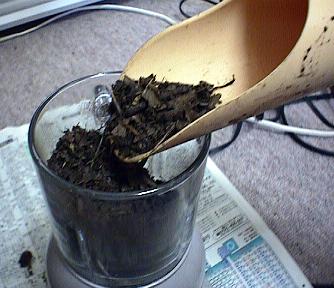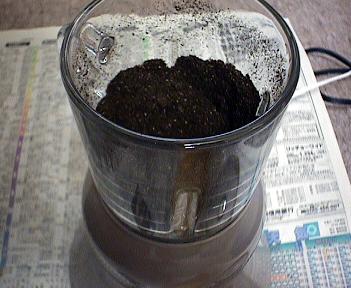4. Breeding of Miyama Kuwagata (Lucanus maculifemoratus stag beetle)
Don't let them stumble to death.
Separate the male as soon as you confirm coitus.
Rearing imagoes to get eggs 1.
I explained about this already a little in the "Preparation for rearing", too. Here is how you prepare the Miyama mat.
The one on the left is common decayed wood flake mat and the one on the right is dedicated Miyama mat. Do you see the difference? It is extremely fine.
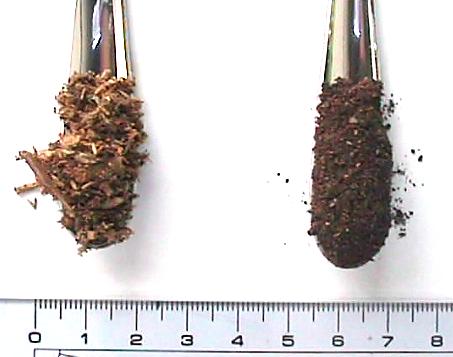 Rearing imagoes to get eggs 2.
Rearing imagoes to get eggs 2.
Their life as an imago is short. So the key to your success in getting eggs is to prolong their life. One of the common reasons for death is "stumbling". The Miyama male walks a lot on branches looking for its mate. So if it is kept in a small container, it tries to climb up the plastic wall in vain and falls on its back. Then it becomes exhausted trying to roll back to its normal position. You need to prepare some measures to avoid such accidents.
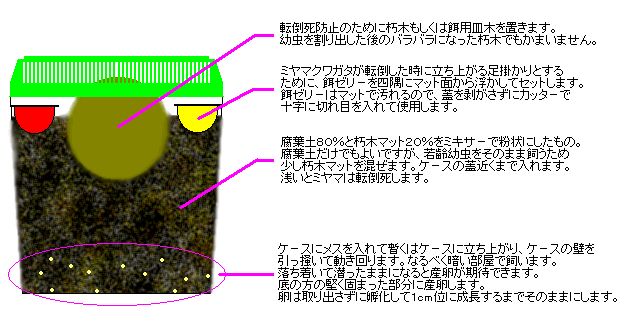 Set the container as shown above.
Set the container as shown above.
Fill the container almost completely up to the top with the fine powder mat (leaf compost and wood flake mixture).
This prevents the male from standing up to scratch the wall.
A middle-sized plastic container can possibly allow the rearing of one male and 3 females.
A large plastic container can possibly allow the rearing of one male and 5 females.
I think the limit for the 60 liter tank in the picture below would be 2 males and 6 females.
In this case, you can't expect the males to live long, and the chances of getting eggs are rather low. It is hard to control the mat under uniform and adequately moist conditions in excessively large cases, and the imagoes tend to be restless there. Such cases are for those who care more for fancy looks or when there are imagoes to rear. In my case, this large tank was for securing my study budget from the Ministry of Finance (my wife). I needed it as a persuasive presentation for those who don't rear stag beetles, who would say "Wow!" upon being impressed by the fancy rearing environment.


|
If your purpose is to breed them over generations, the most effective choice is to rear one male with two females in a middle sized plastic container, though it may look pretty childish. It is easier to keep the moisture of the mat uniform and to check for the death of imagoes and eggs.
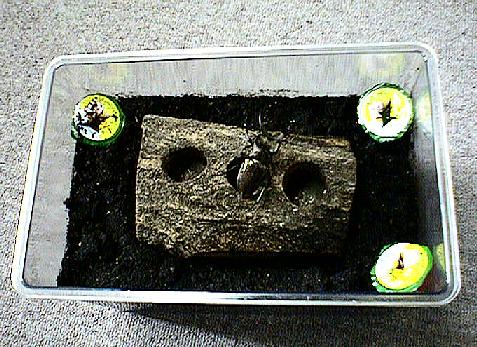
Rearing imagoes to get eggs 3.
A high temperature like 30 degrees C very much shortens their life. A well air-conditioned room in which you feel a little chilly (under 25 degrees C) should suppress unnecessary activity and lead to longer life expectancy.
Rearing imagoes to get eggs 4.
You had better keep the environment dark, as they are strongly attracted to light. Even in an unlighted room, they scratch the wall toward the dim light coming through the curtain. This can be one of the causes of shortened life. Cover the rearing case completely with a cardboard box or keep it in a closet to avoid stimuli.
Rearing imagoes to get eggs 5.
Miyama prefers high humidity. Spray water with the atomizer every day.
Rearing imagoes to get eggs 6.
If the female refuses coitus, the male often pinches the female to death. The female also sometimes bites and cuts off the tarsi of the male. I wonder if there is a congeniality issue among them. So I change the males and females in rotation till I confirm their coitus. As soon as I confirm it, I separate the male and put it into another rearing case. The picture shows one such isolated male. You might think it's a pity, but it will surely survive longer if it does not fight with others.

Rearing imagoes to get eggs 7.
When the female hides under the mat for many days, and you begin to wonder "Is it dead?", your breeding has probably been successful. I have often found a dead female near its eggs.
Below is a chart of Miyama's life cycle, and what I did in one case of rearing in a greenhouse. I used the greenhouse to shorten the larva period, as it is fairly long under natural conditions. The larvae I keep outside the greenhouse are still larvae now, in their second year.

Index
